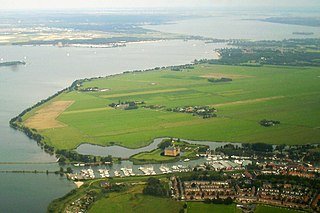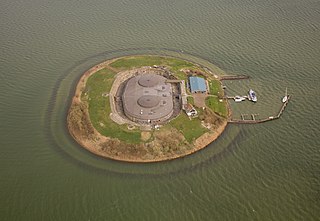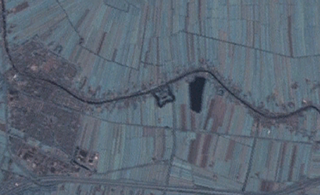Related Research Articles

Beemster is a former municipality in the Netherlands, in the province of North Holland. The Beemster is the first polder in the Netherlands reclaimed from a lake, the water extracted by windmills between 1609 and 1612. The original well-ordered landscape of fields, roads, canals, and dykes has been preserved intact. A grid of canals parallels the grid of roads in the Beemster. The larger feeder canals are offset by approximately one kilometer from the larger roads.

Muiden is a city and former municipality in the Netherlands, in the province of North Holland. It lies at the mouth of the Vecht and is in an area called the Vechtstreek. Since 2016, Muiden has been part of the new municipality of Gooise Meren.

Uitgeest is a municipality and a town in the Netherlands, in the province of North Holland.

Uithoorn is a municipality and a town in the Netherlands, in the province of North Holland.

Weesp is a city and an urban area in the municipality of Amsterdam in the province of North Holland, Netherlands. It had a population of 20,445 in 2021. It lies on the river Vecht and next to the Amsterdam–Rhine Canal in an area called the Vechtstreek. The former municipality of Weesp merged with Amsterdam on 24 March 2022.

Willemstad is the capital and largest city of Curaçao, an island in the southern Caribbean Sea that is a constituent country of the Kingdom of the Netherlands. It was the capital of the Netherlands Antilles prior to that entity's dissolution in 2010. The historic centre of the city consists of four quarters: the Punda and Otrobanda, which are separated by the Sint Anna Bay, an inlet that leads into the large natural harbour called the Schottegat, as well as the Scharloo and Pietermaai Smal quarters, which are across from each other on the smaller Waaigat harbour. Willemstad is home to the Curaçao synagogue, the oldest surviving synagogue in the Americas. The city centre, with its unique architecture and harbour entry, has been designated a UNESCO World Heritage Site.

Kinderdijk is a village in the municipality of Molenlanden, in the province of South Holland, Netherlands. It is located about 15 km east of Rotterdam.

The Stelling van Amsterdam is a 135-kilometre (84 mi) fortification line around Amsterdam, which would function as a national redoubt. It comprises 45 forts, as well as dams, dikes, locks, pumping stations, batteries and casemates. The forts are 10–15 kilometres (6.2–9.3 mi) from the centre and lowlands, which can easily be inundated in time of war. The inundation was designed to give a depth of about 30 centimetres (12 in), too little for boats to cross. Any buildings within 1 kilometre (0.62 mi) of the line had to be made of wood so that they could be burnt and the obstruction removed.

The Dutch Waterline was a series of water-based defences conceived by Maurice of Nassau in the early 17th century, and realised by his half brother Frederick Henry. Combined with natural bodies of water, the Waterline could be used to transform Holland, the westernmost region of the Netherlands and adjacent to the North Sea, almost into an island. In the 19th century, the Line was extended to include Utrecht.

Pampus is an artificial island and late 19th-century sea fort located in the IJmeer near Amsterdam. Pampus now belongs to the municipality of Gooise Meren and is open to visitors.

The Grachtengordel, known in English as the Canal District, is a neighborhood in Amsterdam, Netherlands located in the Centrum district. The seventeenth-century canals of Amsterdam, located in the center of Amsterdam, were added to the UNESCO World Heritage List in August 2010. The Amsterdam Canal District consists of the area around the city's four main canals: the Singel, the Herengracht, the Keizersgracht, and the Prinsengracht. From the Brouwersgracht, the canals are generally parallel with one another, leading gradually southeast into the Amstel river.

The Wierickerschans Fort is a part of the Old Dutch Waterline or "Oude Hollandse Waterlinie". This was a defence system that allowed large parts of the country (Holland) to be flooded (inundated). Thus protecting the main towns and city in the West against invading forces from the East. It was in use right up to the 19th century. The Fort was built on the site where in 1672 Stadtholder Willem III had his headquarters during the war against the French. The Fort is centrally located within the Old Dutch Waterline that stretched from Muiden down to the Biesbosch.
Stelling is a surname. Notable people with the surname include:

The walls of Amsterdam were built in the Middle Ages to protect the city against attack. The Medieval walls were replaced with a series of bastions in the 17th century. In the 19th century, the walls were torn down and replaced with the Defence Line of Amsterdam, a fortification line which encircled Amsterdam at a distance from the city.

Mouse Fort is a Dutch fort in Muiden. The fort is part of the Stelling van Amsterdam, the UNESCO World Heritage site that consists of a set of forts around the city of Amsterdam.

Fort Island is an island in the Essequibo River located in the Essequibo Islands-West Demerara region of Guyana. It is about 16 kilometres (10 mi) from the mouth of the river, and to the east of Hogg Island. In 1687, a wooden fort was built on the island. In 1744, Fort Zeelandia was constructed and served as the capital of Essequibo, a Dutch colony which is nowadays part of Guyana. In 1752, the Court of Policy was built on the island as the legislative body for the colony.

The West Brabant waterline is a Dutch military defense line based on inundation.
RAAAF is an experimental studio operating at the crossroads of visual art, architecture, and academic philosophy. The studio is based in Amsterdam and was founded in 2006 by Prix de Rome (Netherlands) laureate Ronald Rietveld and philosopher Erik Rietveld.
References
- ↑ Geurts, Lize (26 July 2021). "Nieuwe Hollandse Waterlinie en Koloniën van Weldadigheid op Unesco Werelderfgoedlijst". NRC (in Dutch). Retrieved 2 September 2024.
- ↑ "Dutch Water Defence Lines". whc.unesco.org. Retrieved 2 September 2024.